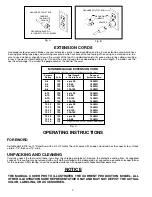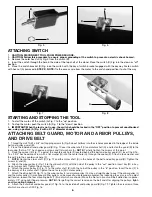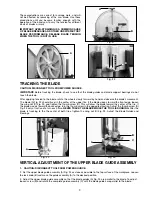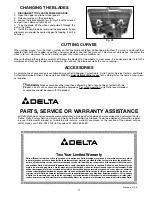
3
ADDITIONAL SAFETY RULES
FOR BAND SAWS
1.
IF you are not thouroughly familiar
with the operation of
band saws, obtain advice from your supervisor, instructor, or
some other qualified person.
2.
Make sure wiring codes
and recommended electrical
connections are followed and that tool is properly grounded..
3.
Make sure
that the saw blade teeth point downward
toward the table.
4.
Adjust
the upper guide about 1/8" above the work.
5.
Make sure
that the blade tension and blade tracking are
properly adjusted.
6.
Stop the machine
before removing scrap pieces from the
table.
7.
Always
keep hands and fingers away from the blade..
8.
Check
for proper blade size and type.
9
.
Hold workpiece
firmly against the table.
DO NOT
attempt
to saw stock that does not have a flat surface, unless a suitable
support is used.
10.
Hold
material firmly and feed into blade at a moderate
speed.
11
.
Turn off the tool
if the material is to be backed out of an
uncompleted or jammed cut.
12.
Make “release cuts before cutting long curves.
13.
Shut off power
and clean the band saw and work area
before leaving the tool.
IMPORTANT: When the tool is not in use, the switch
should be locked in the “OFF” position to prevent un-
authorized use.
14.
ADDITIONAL INFORMATION
regarding the safe and
proper operation of this product is available from the National
Safety Council, 1121 Spring Lake Drive, Itasca, IL 60143-3201 in
the Accident Prevention Manual for Industrial Operations and
also in the Safety Data Sheets provided by the NSC. Please also
refer to the American National Standards Institute ANSI 01.1
Safety Requirements for Woodworking Machinery and the U.S.
Department of Labor OSHA 1910.213 Regulations.†
POWER CONNECTIONS
A separate electrical circuit should be used for your tools. This circuit should not be less than #12 wire and should be protect-
ed with a 20 Amp time lag fuse. If an extension cord is used, use only 3-wire extension cords which have 3-prong grounding
type plugs and matching receptacle which will accept the tool’s plug. Before connecting the motor to the power line, make sure
the switch is in the “OFF” position and be sure that the electric current is of the same characteristics as indicated on the tool.
All line connections should make good contact. Running on low voltage will damage the motor.
WARNING: DO NOT EXPOSE THE TOOL TO RAIN OR OPERATE THE TOOL IN DAMP LOCATIONS.
MOTOR SPECIFICATIONS
Your tool is wired for 120 volt, 60 HZ alternating current. Before connecting the tool to the power source, make sure the
switch is in the “OFF” position.
GROUNDING INSTRUCTIONS
WARNING: THIS TOOL MUST BE GROUNDED WHILE IN USE TO PROTECT THE OPERATOR FROM
ELECTRIC SHOCK.
1. All grounded, cord-connected tools:
In the event of a malfunction or breakdown, grounding pro-
vides a path of least resistance for electric current to reduce
the risk of electric shock. This tool is equipped with an electric
cord having an equipment-grounding conductor and a
grounding plug. The plug must be plugged into a matching
outlet that is properly installed and grounded in accordance
with all local codes and ordinances.
Do not modify the plug provided - if it will not fit the outlet, have
the proper outlet installed by a qualified electrician.
Improper connection of the equipment-grounding conductor
can result in risk of electric shock. The conductor with insu-
lation having an outer surface that is green with or without
yellow stripes is the equipment-grounding conductor. If
repair or replacement of the electric cord or plug is neces-
sary, do not connect the equipment-grounding conductor to
a live terminal.
Check with a qualified electrician or service personnel if the
grounding instructions are not completely understood, or if in
doubt as to whether the tool is properly grounded.
Use only 3-wire extension cords that have 3-prong grounding
type plugs and matching 3-conductor receptacles that accept
the tool’s plug, as shown in Fig. A.
Repair or replace damaged or worn cord immediately.
2. Grounded, cord-connected tools intended for use on a
supply circuit having a nominal rating less than 150 volts:
If the tool is intended for use on a circuit that has an outlet that
looks like the one illustrated in Fig. A, the tool will have a
grounding plug that looks like the plug illustrated in Fig. A
.
A
temporary adapter, which looks like the adapter illustrated in
Fig. B, may be used to connect this plug to a matching 2-con-
ductor receptacle as shown in Fig. B if a properly grounded
outlet is not available. The temporary adapter should be used
only until a properly grounded outlet can be installed by a qual-
ified electrician. The green-colored rigid ear, lug, and the like,
extending from the adapter must be connected to a perma-
nent ground such as a properly grounded outlet box.
Whenever the adapter is used, it must be held in place with a
metal screw.
NOTE: In Canada, the use of a temporary adapter is not
permitted by the Canadian Electric Code.
WARNING: IN ALL CASES, MAKE CERTAIN THE
R E C E P TA C L E I N Q U E S T I O N I S P R O P E R LY
G R O U N D E D . I F Y O U A R E N O T S U R E , H A V E A
QUALIFIED ELECTRICIAN CHECK THE RECEPTACLE.






























